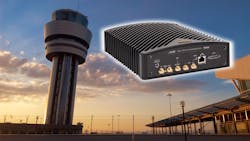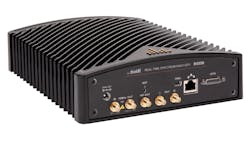Cleared for Takeoff: Pinning Down RFI Around Airports
Large airports rely on a variety of wireless signals distributed across a wide range of frequencies. Successful flights depend on advanced wireless communication systems between the tower and an aircraft, radio navigation systems like radar, and precision landing systems that calculate location data in real-time. Busy airports manage thousands of takeoffs and landings each day with little room for error. Any disruption caused by RF interference can end in disaster.
The Challenge
The proliferation of wireless devices means that interference, whether intentional or accidental, is more common and more difficult to detect. Due to the size of an airport, a single spectrum analyzer doesn’t have the coverage needed to get a reliable view of the spectrum environment.
Users in the control tower need a solution that’s compact, portable, and can be deployed remotely, allowing it to be placed on a vehicle or networked with other analyzers and deployed for continuous monitoring. Traditional spectrum analyzers that are designed for the lab are too large, too expensive, and not designed for this type of monitoring application.
Airports must monitor the wireless spectrum and rapidly detect inadvertent or malicious sources of interference, locate the source, and disable it to mitigate the impact on passenger safety.
The Solution
For such applications, facilities such as airports need a means of monitoring the spectrum with compact, portable instruments that can easily be placed, say, on a truck, for advanced drive tests and/or interference hunting around the property and its environs. One example of this type of instrument, the thinkRF R5550 real-time spectrum analyzer, can capture modern communications signals in complex environments. Further, in this scenario, users must deploy multiple remote and networked instruments to gain a continuous and instantaneous view of the entire airfield.
Advanced triggering capabilities can send an alarm any time a signal is detected outside of a designated threshold and users are immediately notified of any abnormal, unknown, or disruptive signal. By integrating an instrument such as the R5550 analyzer with third-party software, users can conduct in-depth analysis and locate the source of the interference.
The Results
By using multiple networked analyzers, airports get a complete view of the spectrum and can rapidly respond to any potential interference, whether inadvertent or malicious. By leveraging these instruments along with advanced analysis software, airports keep operations running smoothly and always maintain passenger safety.
About the Author
Dr. Nikhil Adnani
Chief Technology Officer & VP Sales, thinkRF
Dr. Nikhil Adnani has over 25 years of experience in the wireless technology field. He has held engineering positions at Nortel and Communications Research Centre Canada. Adnani holds a B.Sc. and an M.Sc. from the University of Manitoba and a Ph.D. from Carleton University, all in electrical engineering.


